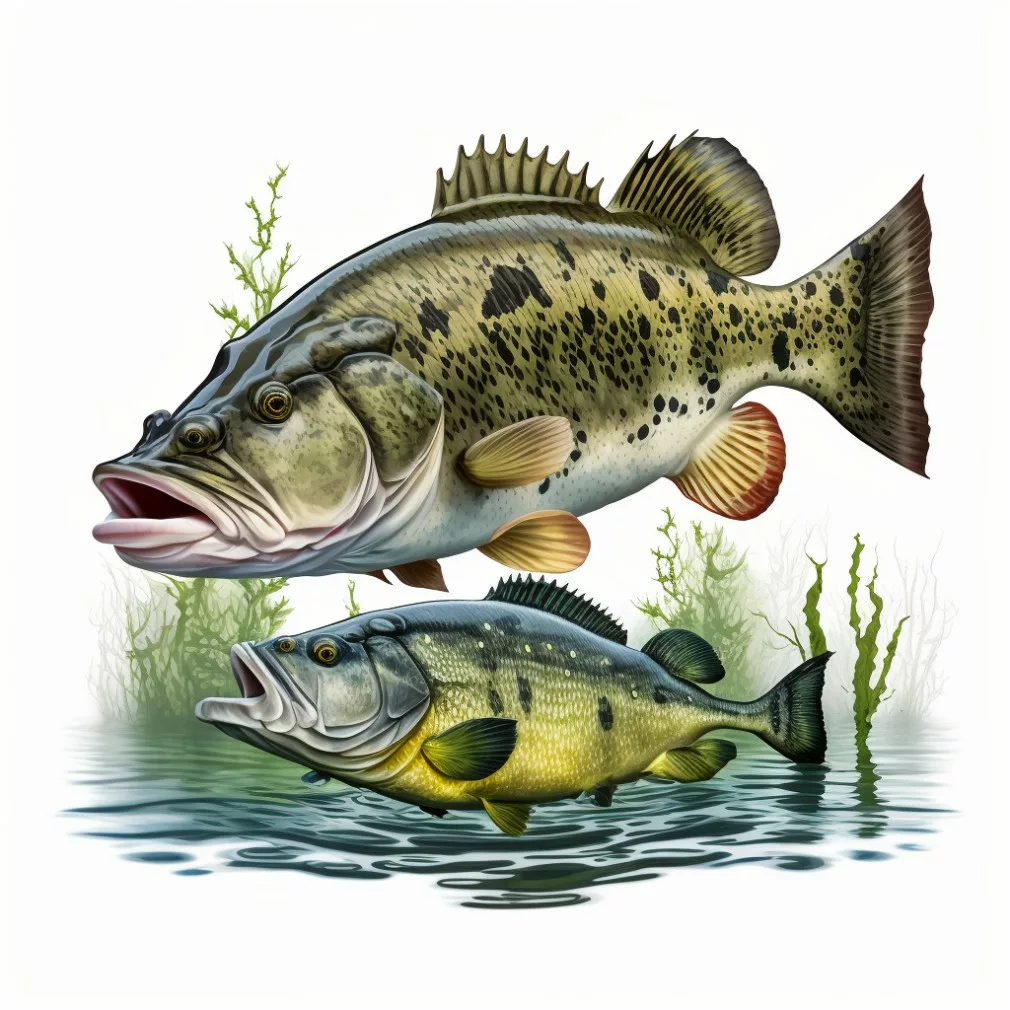If you love to fish for bass, you might’ve already noticed that the spotted bass, or Kentucky Bass, and the largemouth bass look a lot alike. In fact, the overall coloring of the two fish, including any stripes or spots that may be there, can be quite similar, especially since those things can change with both fish depending on the water they inhabit. That being said, it’s a little easier to figure out the differences between the two fish if you know what to look for, and below are some of those things in more detail. The biggest differences between a Largemouth and Spotted Bass are the length of the jaw, dorsal fin, and dark spots across the side and belly of the spotted bass vs the largemouth bass which is mostly white.
Jaw Length
When learning the differences between spotted bass vs. largemouth bass, look at the jaw length first. When the jaw is closed, look at how far back the jaw goes. In a largemouth bass, the jaw will extend past the rear of its eye. In a spotted bass, it does not.
The Dorsal Fin
On a spotted bass, you can clearly see that the top dorsal fin is connected, while the largemouth bass has a dorsal fin that is either separate or almost separate. In many ways, this feature is the most significant of all the rest, making it super-easy to tell the difference between a spotty and largemouth.
The Markers on the Stomach
If you look at the stomach of a bass, it’s easy to tell the difference between spotted bass and largemouth bass. While spotted bass have lines of spots all along the stomach area, largemouth bass usually have just a plain white stomach without these lines.
The Side of the Fish
When you’re trying to decide if the bass you just caught is spotted or largemouth, look at the side of the fish. The spotted bass has a dark lateral line that looks like a series of dots that continue to its belly. The largemouth does not have dark spots on its side or belly.
The Tongue
If you look at the spotted bass’s tongue, you’ll notice that the center of it has a rough patch in the shape of a rectangle. By contrast, a largemouth bass has a tongue that is almost entirely smooth. Keep in mind that this does not include pigmentation, so when trying to decide what type of bass it is, pigmentation is going to look different than this rough patch.
Cheek Scales
Look at the cheek scales of each fish. On a spotted bass, these scales are much smaller than the scales on the rest of its body. On a largemouth bass, all the scales on its body are the same size.
Where the Fish are Located
As far as location is concerned, you can find both spotted bass and largemouth bass in essentially the same locations; namely, the eastern and central parts of the United States. Spotted bass, in fact, is often called Kentucky bass. If you’re an angler, it’s exciting to find both types of bass when fishing!
The Behavior of the Fish
As you can tell from the names of these two fish, a largemouth fish is almost always much bigger than a spotted bass, especially once full-grown. And while these two fish have different physical characteristics, their behaviors tend to be quite different as well. For one thing, spotted bass usually school more than the largemouth bass, and when you hook them, largemouth bass are much more likely to jump and rush to the top than spotted bass. In other words, they try hard to get away when hooked.
Spotted bass usually dive deep and when they’re on the line, they act more like a smallmouth bass. They dive deeper because they think that will help them get away.
Largemouth bass tend to congregate where there is cover or some structure, while spotted bass prefer open and clear water. And one more thing about the physical characteristics of the two fish – spotted bass tend to have much better coloration, but keep in mind that there are exceptions to this rule.
Other Differences Between Spotted and Largemouth Bass
In some instances, even if you know what to look for, it can be difficult to notice whether a fish is a spotted bass or a largemouth bass. Even though the dorsal fins are what a lot of people look at, it’s sometimes easier to look at other features when you want to know what type of bass it is. In addition, there are other differences between these two types of fish that you might like to know.
First of all, spotted bass live for about six years, while largemouth bass usually live for around 16 years, which is roughly three times longer. Spotted bass love to join schools of other fish, while the largemouth bass is usually a solitary fish. You can often find spotted bass out in the open because they love clear waters, so you can even catch them as deep as 30 feet under the water.
By contrast, largemouth bass love to swim in shallow waters and don’t care if the water is clear. During the winter months, spotted bass tend to stay active, while the largemouth bass will swim slower when the temperatures get lower.
How do you Catch Largemouth or Spotted Bass Fish?
As a general rule, the larger the bait and lures, the better luck you’ll have catching largemouth bass. Spotted bass is usually easier to catch with lures such as crankbaits, small plastic worms, jigs, crawfish, and spinners. Largemouth bass, on the other hand, tend to do better with shad, minnows, shiners, worms, and crawfish.
As far as where to find these fish, look for spotted bass in slow-moving freshwater streams and reservoirs, but not in natural ponds or lakes. On the other hand, largemouth bass can be found nearly anywhere. Keep in mind that largemouth bass do not like the cold and will hug vegetation and structure. If you look near the runoff, you can usually find largemouth bass easily.
No one knows why some of these things hold true; it might be just behavioral differences or the result of evolution. One thing is certain, though – once you learn the differences between spotted bass and largemouth bass, you’ll realize it is fairly easy to tell them apart from that point forward.
Good Fishing,
OP Editor

